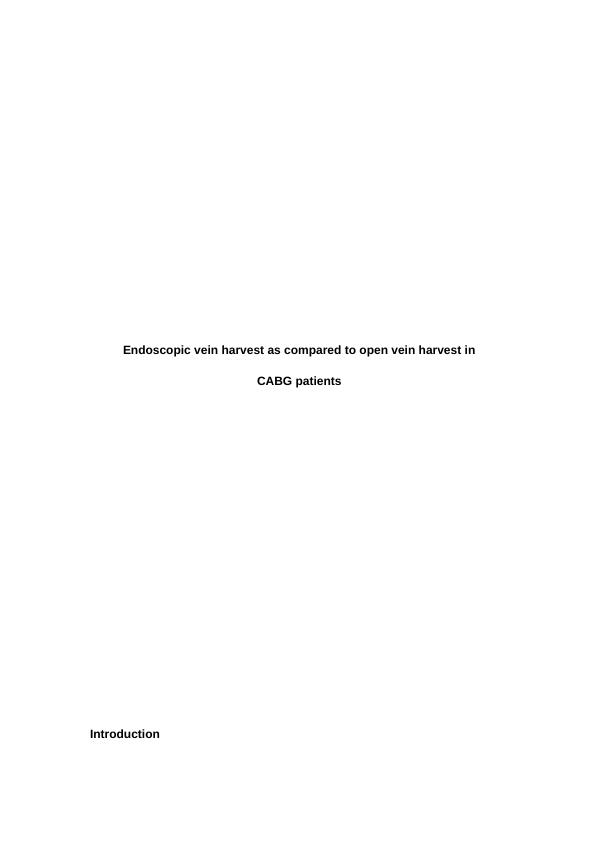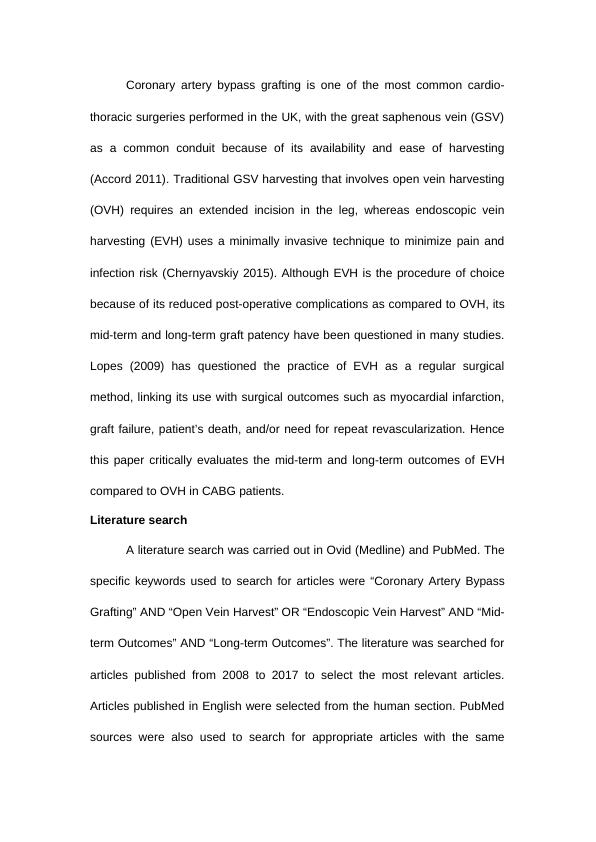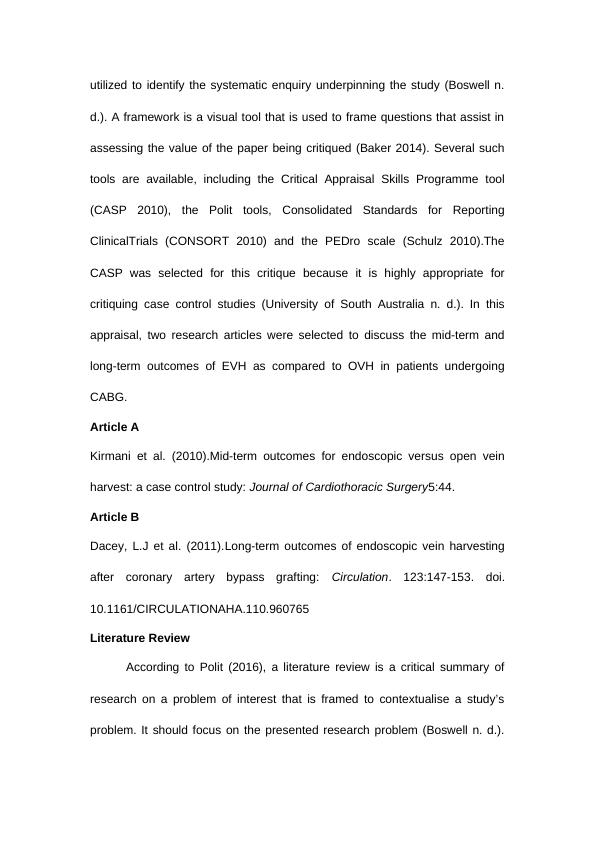Ask a question from expert
Endoscopic Vein Harvesting for Coronary Bypass Grafting
20 Pages4371 Words284 Views
Added on 2020-03-28
Endoscopic Vein Harvesting for Coronary Bypass Grafting
Added on 2020-03-28
BookmarkShareRelated Documents
Endoscopic vein harvest as compared to open vein harvest inCABG patientsIntroduction

Coronary artery bypass grafting is one of the most common cardio-thoracic surgeries performed in the UK, with the great saphenous vein (GSV)as a common conduit because of its availability and ease of harvesting(Accord 2011). Traditional GSV harvesting that involves open vein harvesting(OVH) requires an extended incision in the leg, whereas endoscopic veinharvesting (EVH) uses a minimally invasive technique to minimize pain andinfection risk (Chernyavskiy 2015). Although EVH is the procedure of choicebecause of its reduced post-operative complications as compared to OVH, itsmid-term and long-term graft patency have been questioned in many studies.Lopes (2009) has questioned the practice of EVH as a regular surgicalmethod, linking its use with surgical outcomes such as myocardial infarction,graft failure, patient’s death, and/or need for repeat revascularization. Hencethis paper critically evaluates the mid-term and long-term outcomes of EVHcompared to OVH in CABG patients. Literature searchA literature search was carried out in Ovid (Medline) and PubMed. Thespecific keywords used to search for articles were “Coronary Artery BypassGrafting” AND “Open Vein Harvest” OR “Endoscopic Vein Harvest” AND “Mid-term Outcomes” AND “Long-term Outcomes”. The literature was searched forarticles published from 2008 to 2017 to select the most relevant articles.Articles published in English were selected from the human section. PubMedsources were also used to search for appropriate articles with the same

keywords. The search was limited to case-control studies, which involvecomparing cases with controls (THS 2015).An article’s title should provide a concise, clear description of the study(Boswell n. d.). It should inculcate a concise perception of the basic nature ofthe study (Polit 2016). The titles of sixty-two articles were selected based onthe search terms, among which the twelve most relevant articles wereselected from Ovid (Medline) and PubMed. From these, the two mostappropriate articles were carefully selected and critically appraised toinvestigate the mid-term and long-term outcomes of EVH versus OVH inCABG patients in order to scrutinize the best evidence available to reducepost-operative complications. An abstract should condense the main studypoints (Iverson 2014). As given by Polit (2016), quick reading of the abstractshould provide valuable insight into the study’s complexity: hence, theabstracts of several studies were read carefully to select two appropriatestudies to compare the mid-term and long-term outcomes of OVH and EVH inCABG patients and critically evaluate them. The essence of critically appraising a research study lies in attaining abalanced critical appraisal (Polit 2016). The critical evaluation report shouldbe synthesized in such a way that both merits and demerits of the research-methods used should be included along with their practical applicability in anyhealthcare setting (Merriam-Webster 2015; Aveyard 2010). Moreover, in abalanced critical appraisal, some degree of logic and objectivity must be

utilized to identify the systematic enquiry underpinning the study (Boswell n.d.). A framework is a visual tool that is used to frame questions that assist inassessing the value of the paper being critiqued (Baker 2014). Several suchtools are available, including the Critical Appraisal Skills Programme tool(CASP 2010), the Polit tools, Consolidated Standards for ReportingClinicalTrials (CONSORT 2010) and the PEDro scale (Schulz 2010).TheCASP was selected for this critique because it is highly appropriate forcritiquing case control studies (University of South Australia n. d.). In thisappraisal, two research articles were selected to discuss the mid-term andlong-term outcomes of EVH as compared to OVH in patients undergoingCABG.Article AKirmani et al. (2010).Mid-term outcomes for endoscopic versus open veinharvest: a case control study: Journal of Cardiothoracic Surgery5:44. Article BDacey, L.J et al. (2011).Long-term outcomes of endoscopic vein harvestingafter coronary artery bypass grafting: Circulation. 123:147-153. doi.10.1161/CIRCULATIONAHA.110.960765Literature ReviewAccording to Polit (2016), a literature review is a critical summary ofresearch on a problem of interest that is framed to contextualise a study’sproblem. It should focus on the presented research problem (Boswell n. d.).

End of preview
Want to access all the pages? Upload your documents or become a member.
Related Documents
School of Healthcare Scienceslg...
|45
|16474
|29
Research Proposal Form for School of Healthcare Scienceslg...
|7
|2129
|187
Effects of Rehabilitation on Post CABG Patients with Anxiety and Depressionlg...
|18
|6373
|163
Critical Review of Research Methodologies in Dual Antiplatelet Therapy Studylg...
|9
|3313
|38
CABG vs PTCA using drug eluting stents for the treatment of left main coronary artery diseaselg...
|45
|13958
|85
The Effect of Tourniquet Use in Total Knee Arthroplasty - PDFlg...
|21
|4738
|190